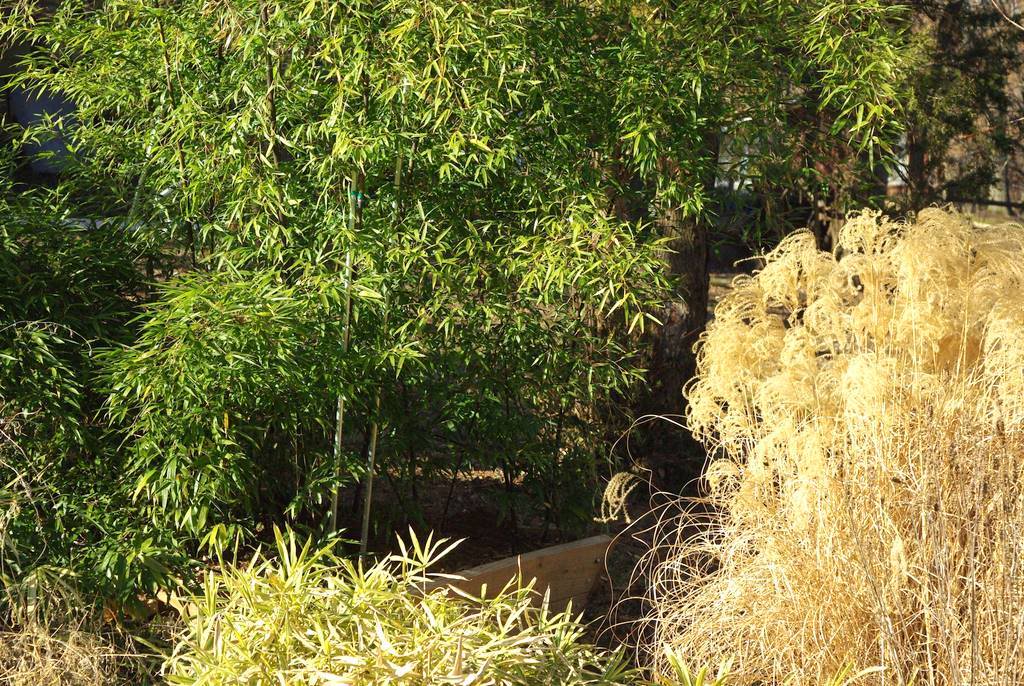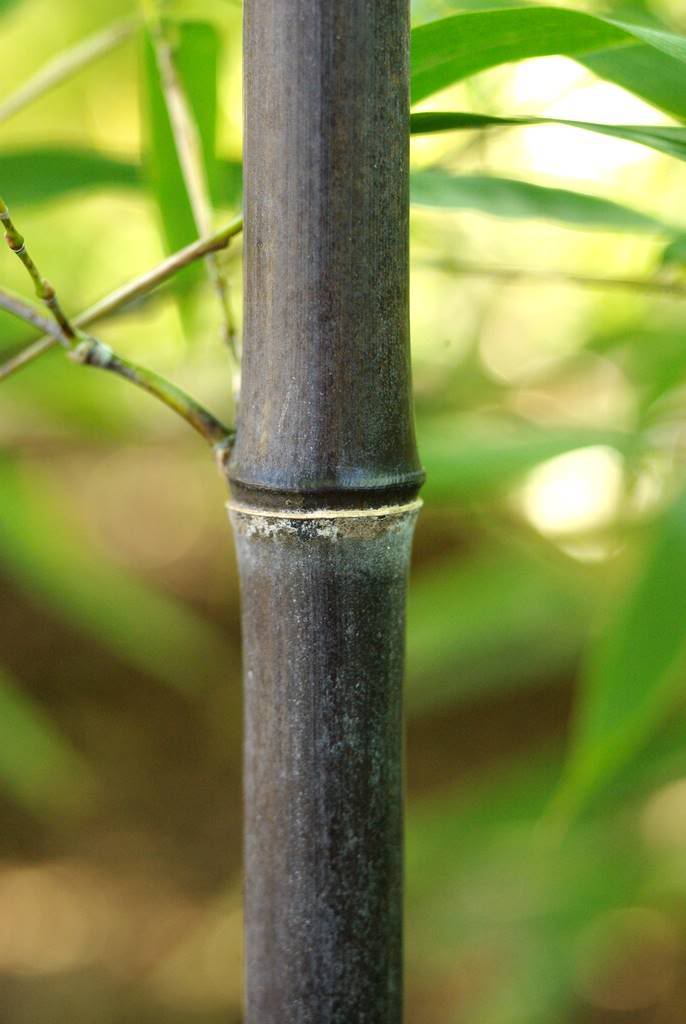Green to black
>> Friday, January 13, 2012 –
bamboo
Of the bamboo varieties I grow, some of them are "marginal", in that they're not reliably cold-hardy for my zone 6 garden. (All of them are "temperate" as opposed to tropical or sub-tropical, so can take some degree of below-freezing temperatures.) The good news is that unlike perennials which die when they're not cold-hardy enough, the bamboo that isn't cold-hardy enough will at worst "top-kill", meaning it loses all of the above-ground growth. The rhizomes are still alive and will produce new culms once it warms up.
This is not what bamboo growers strive for though. We want the big species of bamboo to get big -- produce thick and tall culms each year. The key to this is avoiding top-kill. Which brings me back to "marginals". These are the bamboos that have the greatest chance of losing all of their leaves each winter, or even top-killing. One that I'm most worried about each year in my garden is black bamboo: Phyllostachys nigra.
I got this plant in 2008 from Brad at Needmore Bamboo as a freebie. He was in the process of removing his nigra because he wasn't happy with it -- it wasn't cold-hardy enough. Since we thought that my winters were typically a few degrees warmer than his (which turned out to be true but unpredictable -- sometimes it's colder here than there) he thought that nigra would be worth a try in my garden.
 |
| This is it in 2008 while it was still in its pot. The hummingbird liked the gently arching culms as much as I did. |
Last winter (its second in the ground) there were only a handful of smaller culms, so I bent them down to the ground and tarped over them. This kept them alive all winter and in the spring I was rewarded with several 10' (3m) tall culms.
The thing about the culms though is that they start out green, and only turn black after a year or two. If the plant top-kills the culms don't have enough time to turn the black color that makes this plant so attractive (in my opinion), although the arching habit of the culms makes it garden-worthy too.
Good news though: the new culms on my plant have already turned an acceptable shade of black -- for the most part.
I'm not sure if the blackness starts at the bottom of the culm and works its way up, or if culms that are exposed to more sun take more time to darken, but the higher parts of these culms (which also happen to get more sunlight) are only partially black:
You can see how the transformation takes place, as a spotting that spreads until the culm loses its verdant hue:
There are forms of nigra that never completely blacken, and retain a spotted or splotchy look, and although I think they're somewhat attractive, it's the glossy black culms that I want.
Therefore I'm hoping that some of these will make it through the winter so I'll get to enjoy the mix of black culms and bright green leaves all year long, instead of just through the last parts of the year.
Note: although we've had an overall mild winter so far, we're currently in a cold spell. Low about 15ºF/-9ºC for a couple of days, with gusty winds before it warms back up. Cold wind is the worst for bamboo, so we'll see how my nigra does. Fingers crossed.
.











P. nigra is for now my favorite!! and i'm also a litle conserd bout the winters becouse it gets to low. last year he didn't make taller clums as year befour but smaller. i hope this year will be bether since is not so cold yet :D.
I visited a garden this spring (I think it was Sean Hogan's) which had some LARGE clumps of mature this bamboo...they were stunning...but you need A LOT of space to do them justice!
ALan, blackening of the culms seems to start at the bottom. I have quite a few that are black at the bottom but still mottled and then green at the top. Cold weather seems to speed up the process.
Beautiful bamboo all around, one of my favorites for sheer impact. I like the small leaves too.
Alan, I hope you nigra comes through. Mine here in Oregon has survived single digit temperatures 4 days running, without any burn. This winter has been down to the teens or low 20's nightly for a month and a half- and it still looks as fresh as it did in October. Granted, though- our days and days below freezing were also high pressure stagnation days, with zero wind.
I should have mentioned that my gardening friend Mike has a planting of nigra that has done so-so for him -- gets quite a bit of damage most winters -- but he's had it for many years.
There was also a yard a few blocks from me that had nigra growing in it. I saw it from the street while on winter walks, and it seemed to always have blonde leaves by the end of the winter. Plus it had spread quite a bit and wasn't particularly tall. I think it's been removed.
If you can grow many bamboos in raised boxes successfully, you might be in a warmer zone than the climate zone map states. How often have you seen sub-zero temperatures during the winter?
You may have a micro-climate in your garden which keeps temps above 0F especially with the addition of a pond which may allow you to grow some marginal boos such as the vivax varieties or whatever needmore has that top kills every winter. My winter extremes are almost identical to needmore as the avg winter extreme is -2.2F.